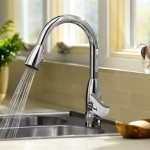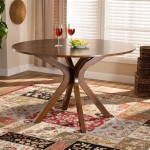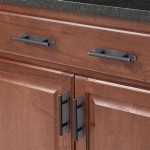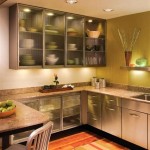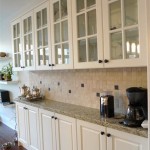What Goes In Kitchen Cabinets
Kitchen cabinets are the backbone of any kitchen, providing essential storage space for a multitude of items. Organizing these cabinets effectively maximizes space and streamlines cooking processes. Understanding what typically goes in kitchen cabinets allows for optimal kitchen functionality and a clutter-free environment.
Dinnerware and Serving Dishes: This category encompasses everyday dishes, bowls, plates, and serving platters. Placement depends on frequency of use. Everyday items should be in easily accessible cabinets, while special occasion dishes can be stored in higher or less accessible areas.
Glassware and Drinkware: Glasses, mugs, cups, and stemware typically reside in upper cabinets, often near the sink or dishwasher for easy access after cleaning. Consider using shelf dividers or organizers to maximize space and prevent breakage.
Cookware: Pots, pans, and baking dishes are best stored near the stove or oven. Options include stacking them vertically with pan protectors or utilizing specialized pot and pan organizers within drawers or cabinets.
Bakeware: Baking sheets, cake pans, muffin tins, and other baking essentials can be stored together, often in lower cabinets due to their weight and size. Vertical dividers or racks help maintain organization and prevent damage.
Food Storage Containers: These containers, along with their lids, can be a source of disorganization. Investing in matching sets and employing drawer dividers or specialized organizers can help maintain order and maximize space efficiency.
Pantry Staples: Dry goods, canned goods, and other non-perishable food items are often stored in a designated pantry cabinet. Organizing these items by category (grains, canned vegetables, etc.) and using clear containers allows for easy identification and inventory management.
Small Appliances: Appliances used less frequently, such as blenders, food processors, and stand mixers, can be stored in lower cabinets or a designated appliance garage. Keeping them in their original boxes provides protection and can prolong their lifespan.
Cleaning Supplies: While some prefer to store cleaning supplies under the sink, a dedicated cabinet, potentially away from food storage areas, is recommended for safety. Organizing these supplies on a tiered shelf or in a caddy enhances accessibility.
Linens and Textiles: Tablecloths, napkins, placemats, and kitchen towels can be stored in a drawer or a designated cabinet shelf. Folding them neatly and organizing them by type or occasion maintains order and simplifies table setting.
Cutting Boards and Utensils: Cutting boards can be stored vertically in a dedicated slot or alongside baking sheets. Utensils such as spatulas, whisks, and ladles are typically kept in a drawer near the stove for easy access during cooking. Utensil organizers help prevent clutter and facilitate quick retrieval.
Serving Utensils: Serving spoons, forks, and other serving implements are often stored in a drawer or a designated compartment within a cabinet. Keeping them separate from everyday utensils helps prevent confusion and ensures they are readily available when needed.
Specialty Items: Items like specialty cookware, baking supplies, or appliances used for specific cuisines or occasions can be stored in less accessible areas or designated cabinets based on frequency of use.
Organizing Principles for Kitchen Cabinets: Several key principles can guide the organization of kitchen cabinets. Prioritize items based on frequency of use, placing frequently used items in easily accessible locations. Group similar items together to streamline workflows. Optimize vertical space using shelf risers, stackable containers, and vertical dividers. Invest in quality organizers designed for specific items.
Accessibility Considerations: Consider the accessibility needs of all household members when organizing kitchen cabinets. Frequently used items should be within easy reach, and heavier items should be stored in lower cabinets to prevent strain. Adjust shelf heights as needed and consider using pull-out shelves or drawers for enhanced accessibility.
Maintaining Order: Regularly decluttering and reorganizing kitchen cabinets helps maintain order and prevent clutter buildup. Discard expired items, donate unused items, and assess the effectiveness of the current organizational system. Adjustments can be made as needed to optimize functionality and efficiency.
Cabinet Design and Functionality: The design and layout of kitchen cabinets significantly impact storage capacity and accessibility. Features such as pull-out drawers, deep drawers, built-in organizers, and adjustable shelves contribute to efficient organization and ease of use. Consider these features when planning a kitchen renovation or selecting new cabinets.
Space Optimization Techniques: Maximizing space within kitchen cabinets requires strategic organization. Utilizing the full depth of cabinets, using vertical space effectively, and employing drawer dividers and organizers helps create additional storage and improves accessibility. Regularly assessing the contents of cabinets and adjusting the organization as needed helps maintain order and efficiency.

How To Organize Your Kitchen Cabinets And Pantry Feed Me Phoebe

What S Inside Your Cabinet

How To Organize Your Kitchen Cabinets Step By Project The Container Store

Organizing Kitchen Cabinets With A Cork Message Center Rhapsody In Rooms

How To Organize Your Kitchen Cabinets And Drawers She Gave It A Go

Organizing What To Put In The Kitchen Cabinets Goes Where

What S Behind The Kitchen Cabinets Hdr Remodeling

How To Organize Your Kitchen Cabinets And Drawers She Gave It A Go

Kitchen Cabinet Parts Terminology Granite Quartz Countertops Cabinets Factory

How To Organize Your Kitchen Cabinets And Drawers She Gave It A Go

